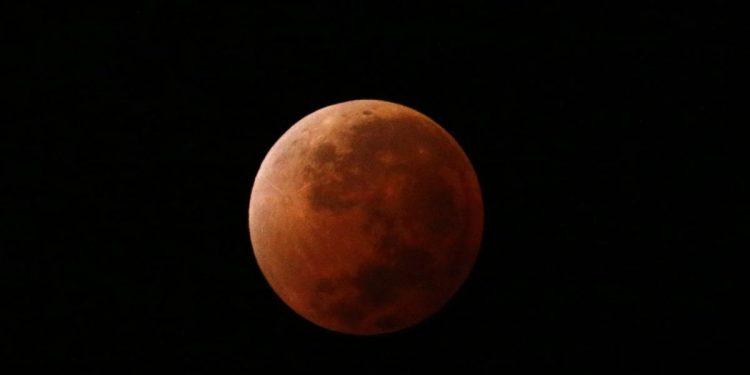- A total lunar eclipse will occur overnight Thursday, turning the surface of the Red Moon.
- This blood of blood becomes red because all sunsets and sunrise on earth are projected.
- Look at the shadow of the earth “bite” the moon and then change its color for the first time in two years.
When the moon becomes frightening Thursday evening, do not panic. It’s not an omen, it’s just an eclipse.
The earth will throw its shadow through the moon, turning its red surface like our planet, our moon and our sun align. This is why total lunar eclipses are sometimes called the “blood moon”.
It will be the first total lunar eclipse in almost two and a half years.
The red color comes from the light of all the sunrise and sunsets that occur through the earth.
What a total lunar eclipse looks like from the Moon. NASA scientific visualization studio
This is because, even if the earth throws its shadow on the moon, the sun always crosses the atmosphere of the earth along the edge of this shadow. These are all the regions where the day goes to the night, and vice versa.
The atmosphere folds sunlight towards the moon. Blue light is dispersed in the atmosphere, which is why the sky is blue. Only the red part of the light spectrum crosses to reach the lunar surface.
The blue light of the sun propagates and the longer light red, orange and the yellow light passes through, turning our red moon. Nasa Goddard Space Flight Center / Scientific Visualization Studio
“It is as if all the sunrise and the sunsets of the world were projected on the moon,” wrote NASA in a blog article.
When and how to see the blood moon
Depending on the time zone in which you are, the eclipse will occur on the evening of March 13 or very early on the morning of March 14.
The shadow of the earth will start to slip on the moon, creating a partial lunar eclipse, at 1 h 09 HE.
To the naked eye, according to NASA, “it seems that a bite is removed from the lunar disc.”
The parts of the moon that are overshadowed will be dark up to 2 h 26 HE, when the eclipse becomes total. The shadow of the earth will completely swallow the moon and throw it in red.
Use binoculars or a telescope to see the eclipse more clearly and look at the briefly red craters of the moon. To take photos, NASA recommends put your phone on a tripod and define the camera to take long exhibitions of at least a few seconds.
The whole will last a little more than an hour, up to 3 h 31 HE where the shadow of the earth continues to pass, creating several overtime hours of partial eclipse. The moon will be completely back to normal at 6 am
If you miss it, don’t worry because it is the first of the three. There will be another total lunar eclipse in September, then another in March.
businessinsider


